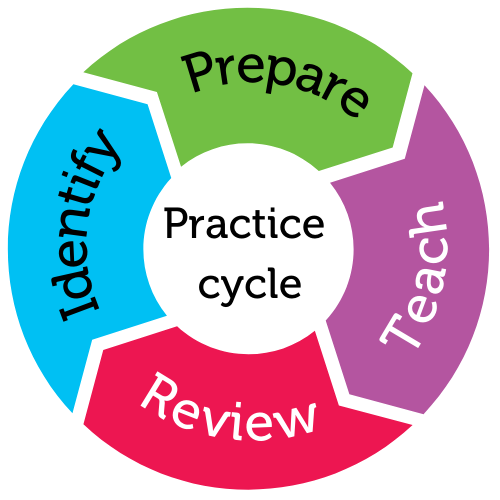
For student year
Helps students to
- understand the task
- build confidence
Helps teachers to
- facilitate independence
- facilitate performance
Summary
Assignment exemplars are an important resource in supporting student learning. They can be used to model the desired format and organisation of a project, demonstrate different standards of an assignment or task, or as a source of inspiration in the beginning stages of an activity. Some students, including those on the autism spectrum, may struggle to understand what is expected of them within assessment frameworks, and how to organise their ideas within those parameters.
Using exemplars with instructions and clear annotations helps students to:
- focus on the content of their work
- understand the requirements of a task
- work more independently
- have greater confidence.
"Providing students with exemplars may assist them to work more independently."
How the practice works
Watch this video for some key points in using assignment exemplars.
Duration 2:19
Australian Professional Standards for Teachers related to this practice
1.6 - strategies to support the full participation of students with disability
4.2 - manage classroom activities
For further information, see Australian Professional Standards for Teachers AITSL page
Preparing to teach
How does it help?
Providing the student with a model or exemplar of an assignment enables the student to focus on creating quality content. The student is then able to focus on demonstrating what they've learned which gives you a more accurate assessment of student progress.
When planning assignments, consider what exemplar could be included. Gather examples of previously completed assignments or create a good model example. Ensure that these adequately represent different expectations based on adjustments.
You should try to:
- Use annotations that explain how each section of the assignment exemplar addresses the assessment task. This supports students to understand the assessment task and the criteria.
- Use clear language to explain why and how the different parts of the assignment meet the criteria. you may also like to highlight certain sections to draw students' attention to the important elements.
- Use exemplars from a range of different tasks.
- Explain that the exemplar is a model for their assignment and that content should not be copied directly.
When giving instructions for the assignment reflect on what was effective and what was not and make appropriate adjustments for the next assignment.
The Australian Curriculum provides work samples for the different curriculum areas. You can use these to assist you in developing your own exemplars.
Link to Australian Curriculum v9 F-10 here.
It works better if:
- the exemplar provided is specific to that particular assignment, e.g. if the assignment outline requires the student to create a Twitter/X feed of a Roman Emperor, create a similar feed, for example the Twitter/X feed of an Egyptian Pharaoh not just direct the student to Twitter/X
- the teacher annotates the exemplar, explaining why it is considered a strong example
- the annotations reflect the marking criteria
It doesn't work if the teacher:
- doesn't consistently provide exemplars for assessments
- doesn't work through the exemplar with the students
- doesn't align the annotations with the assessment criteria
- doesn't explain to the student that the exemplar is only to be used as a model and not something that should be copied directly.
In the classroom
Before
Consider any exemplars you could use with the the assessment task. You may choose to work as a team and create an exemplar that can be used across a subject or year level. Include an example of the assignment in its completed form when developing an assessment outline.
An exemplar should contain annotations outlining how each section of the assignment addresses the assessment outline.
During
When outlining assignment instructions with students, explain that the exemplar is a model for their assignment and content should not be copied directly when giving instructions for the assignment.
Explain why the exemplar demonstrates the appropriate features.
Example approach: You may like to provide the students with 2 examples - one annotated and the other not annotated. You can can work with the students to see if they can identify the elements of the task. You can then show them the annotated version after the discussion.
After
Reflect on practice and make appropriate adjustments for the next assignment set.
Practice toolkit
Practice implementation planner template
We know it's not always easy to keep track of what's working and what isn't. So, we've created this template for you to record and reflect on what you're doing to create more inclusive classrooms. The implementation planner contains:
- guidance around goal setting
- a reflection section (what worked, didn’t work, what to change, and next steps)
- prompting questions.
Implementation planner with examples
Set your professional learning goal for:
Create assignment exemplars
Benefits of goal setting
Setting, working towards, and reflecting on goals helps you grow professionally and improve your practice. You can access AITSL learning resources for teachers to learn more about:How to set goals
The Australian Institute for Teaching and School Leadership recommends using the SMART matrix to frame your goal setting.SMART goals refers to goals that are:
- Specific
- Measurable
- Achievable
- Relevant
- Time-phased
Resources
Create assignment exemplars - Practice Brief
Related Practices

Adjust oral assessments for student success
TEACHING PRACTICE
For student years
Helps students to
- reduce anxiety
- demonstrate knowledge
This practice is from the core research project
Learning Cycle

